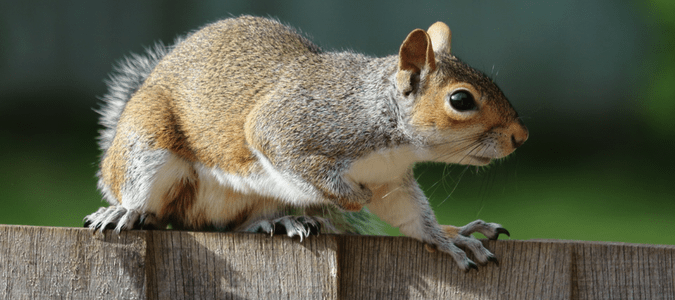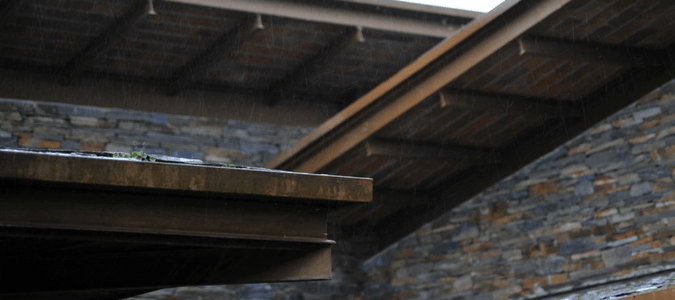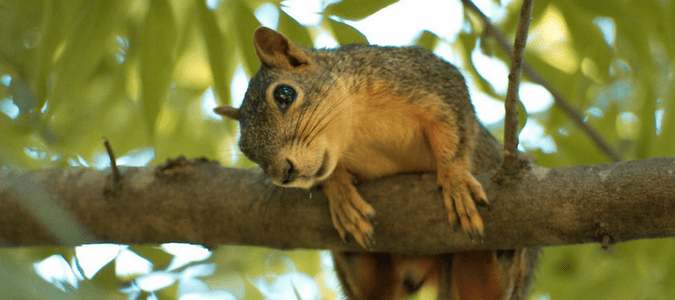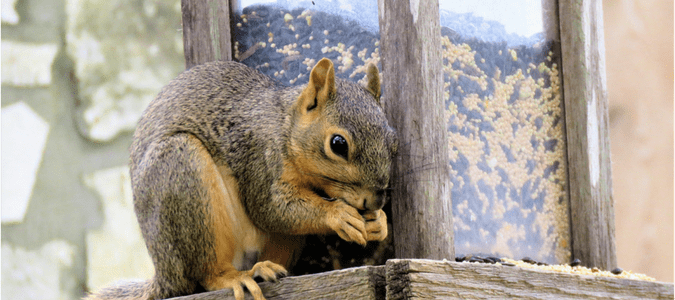
Squirrels can provoke strong feelings in homeowners—primarily negative. Although these animals may look cute and furry, squirrels can dig up your yard, raid your bird feeder, chew through electrical wires, damage your insulation, and leave droppings in your attic.
A squirrel’s incisor teeth grow continuously, and because the rodents chew on everything, they can damage your deck, siding, hammock, fencing, and electronics. If they gnaw their way into your attic, squirrels can expose your belongings to the elements, including rain. Over time, this nuisance pest can even cause structural damage to your home.
Let’s discuss how to deter squirrels from your house, what signs to look for to indicate they are inside, how to keep them from eating from your bird feeder, and tips to remove squirrels from your home.

How To Deter Squirrels From House
The most common types of squirrels are ground squirrels, tree squirrels, and flying squirrels. Ground squirrels eat small animals, including caterpillars, insects, leaves, roots, seeds, and nuts. Tree squirrels prefer acorns, berries, flowers, bark, and nuts and use their climbing skills in city parks and rural environments. Flying squirrels live in tree holes or nests and glide across the air to move from tree to tree. These squirrels eat fruit and nuts but can also eat baby birds and insects.
As with other larger pests, one of the best ways to control squirrels is to prevent them from entering your home in the first place. There are several things you can do to keep these rodents from nesting in your home, including:
- Trimming tree limbs eight to ten feet from the roof of your home. Doing so will make it harder for squirrels to find any openings around your attic, fascia, or eaves to make their way inside.
- They are locating entry points. Since squirrels typically leave your home during the day to forage for food, go into your attic, and find where sunlight comes in. Seal any holes these rascally rodents may have created by chewing their way in.
- You are installing wire mesh on your exterior vents. Squirrels and other critters like to use vents as an easy access route to your home. Screening these openings allows the air to get out and prevents rodents and other creatures from entering.
- You are putting in gutter guards and covering your downspouts to make it harder for these pests to climb to possible entry points.
- You are placing baffles at all openings along your home’s exterior, including your chimney.
- You are picking up any stray pet food that might have been left behind if you feed your pets outside.
- Removing bird feeders—at least temporarily—until squirrel activity has calmed down.
- You are making the area smelly. After closing all your windows and doors, dip a towel in ammonia and wipe along the entry points where the squirrels enter your home.
Maybe you’ve already taken care of what you can outside. But what if you suspect squirrels have already made their way inside?

Squirrels In House: Signs To Look For
There are some telltale signs to look for that can indicate whether you have squirrels in your home. These pests love attics, which offer great protection from predators and the elements. Here are some things to look (or listen) for when determining if these critters are residing in your attic:
Noises
Squirrels are most active in the early mornings and evenings. If you hear noises from above you during this time, squirrels could build a nest in your attic. You may listen to scraping sounds and a squirrel’s constant gnawing and chewing. Young offspring can also make high-pitched chirping sounds, much like birds.
Droppings
If you see droppings in your attic, some critters reside there. Squirrel droppings resemble rat feces, which look like small cylinder-shaped pellets. Since squirrels can carry diseases, don’t handle any waste material you might find. Call in an expert to help, or use gloves and a mask as you clean up the area.
Gnaw Marks
Like a teething puppy, squirrels do chew on anything. They will gnaw on siding, decking, electrical wire, trim, baseboards, and more. Look for damage in and around your soffit, fascia, shingles, or other outer areas of your home around your roof. The injury or holes squirrels can make can vary widely in appearance, depending on the animal’s size and the marks’ location. Holes can be about an inch to three inches in diameter, usually in a semi-circle shape. You may sometimes notice oil residue from a squirrel’s coat around the opening as he or she squeezes through. As you might imagine, holes made by squirrels are more significant than gaps created by rats and mice.
Damaged Wiring or Insulation
Since squirrels like to hide in the attic, it’s the most obvious place to look for signs of squirrel activity. Look for missing or shredded insulation or damaged ductwork, or electrical wires. If these pests have been there awhile, the smell from their urine can be apparent.
Leaks
If there is an unexplained leak, it could be because of one or more squirrels chewing on your roof jacks. These covers extend from our bathrooms outside of our home onto our roof. These exhaust pipes, which seem particularly attractive to squirrels, prevent rainwater from getting into your attic, which can lead to roof rot.
How To Stop Squirrels From Eating Bird Food
As we’ve mentioned, squirrels eat and chew just about anything. If you have a bird feeder in your yard, chances are that a squirrel has helped him or herself to the convenient bounty. How do you save the bird food for the birds and stop squirrels from eating it? Here are a few things you can do:
- Choose a good location for your feeder. If you can, mount the bird feeder away from a tree, wall, or other place a squirrel can reach by shimmying or jumping. Outsmarting a squirrel can be like keeping your kids out of the cookie jar. Your best bet is to hang your feeder so the food is at least four feet above the ground and ten feet away from walls, trees, fences, and overhanging branches.
- Place a baffle above or below the feeder. A baffle is a slick metal or plastic bowl-shaped object that a squirrel will slide right off and onto the ground. You can put a baffle below the bar if your feeder is on a pole. Ensure it is high enough that the squirrel can’t just jump over it. If you hang your bird feeder from a tree or other location, install the baffle on the chain above the feeder to prevent the squirrel from moving down the chain to the food.
- Use a fishing line to attach the feeder to the tree. The fishing line is too thin for a squirrel to use to get to your feeder. However, squirrels can jump great distances, as much as six feet from a standing position, so ensure the feeder is far enough away that a squirrel can’t jump to it from somewhere else. If a squirrel jumps and lands on top of the feeder, the line will probably break, which can result in scattering of bird feed everywhere. If that happens, you can try doubling or even tripling up on your fishing line to make the hanger stronger without giving a mischievous creature a way to catch a ride.
- Use PVC pipe over the rope for the feeder. If you can’t use a fishing line or thin galvanized wire rope, put a slippery PVC pipe over the rope to keep the squirrel from climbing to the feeder. The PVC pipe should be allowed to spin freely to be most effective.
- Use an auto-close feeder. You can purchase several kinds of “squirrel-proof” feeders, which are spring-loaded. When anything weighing more than the average weight of a bird is on the perch, the feeder won’t open for the squirrel to access the food inside.
- Use a cage feeder. These feeders allow birds to enter but have openings too small for a squirrel to enter.
- Pepper the birdseed. Mix any dried or powdered pepper into the birdseed to repel squirrels. This is also an excellent way to use all the extra pepper packets from your pizza deliveries! The birds will still eat the peppered seed, but the squirrels don’t like the spiciness. Another benefit is that you’ll give the birds extra vitamins from the pepper, potentially killing any internal parasites.
- Switch to safflower seed. For whatever reason, squirrels are not fans of safflower. However, some birds don’t like it, so your mileage may vary with this approach.
- Get an outdoor pet. The squirrels stay away as long as the pets run around in your yard.
If none of those options work, and you are at your wit’s end, you can try squirrel removal.

Squirrel Removal Tips
As we have already discussed, some squirrels can cause much damage. Removing them from the area around your home is your best option if they are causing havoc in your yard or attic.
Although you can try waiting until squirrels leave your home alone and closing off entry points, the most effective and humane way to remove squirrels is by laying and checking live traps. Food such as peanut butter, fruit, and nuts have been found effective to lure them in. Place traps close to entry points or where these animals forage, such as:
- next to a wall in your attic, crawlspace, or shed
- near the base of a tree
- near your bird feeders
- along fencelines
- on your roof near tree limbs or power lines
Check your traps often to see if you have been successful. When your web does its job, relocate these creatures about ten miles away from your property to make sure they don’t make their way back. Wear gloves when you transport the trap and hold it by the handle. Check local regulations to make sure to follow laws about transporting wildlife. Once your web is no longer in use, disinfect it to prevent the spread of disease.
Squirrel control is not an easy job. In between scaling ladders to check your roof for damage, poking around in your crawlspace, and dealing with animals that can and will bite, many homeowners opt for outside help when dealing with a squirrel problem. A pest professional can also take steps to seal your home’s entry points and to check periodically to make sure there are no new openings these pests can use to get inside.
ABC Can Handle Your Squirrel Problems
Your relationship with the squirrels in your yard can abruptly change once you realize they have made their way into your attic, dug up your prized petunias, or knocked your bird feeder to the ground for what seems like the hundredth time. ABC’s rodent and wildlife control specialists understand the behavior and habits of these troublesome animals. With the experts on your side, you won’t have to worry about the future escapades of these exasperating backyard residents.
